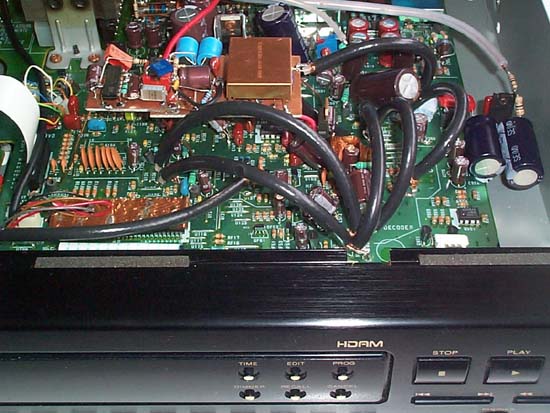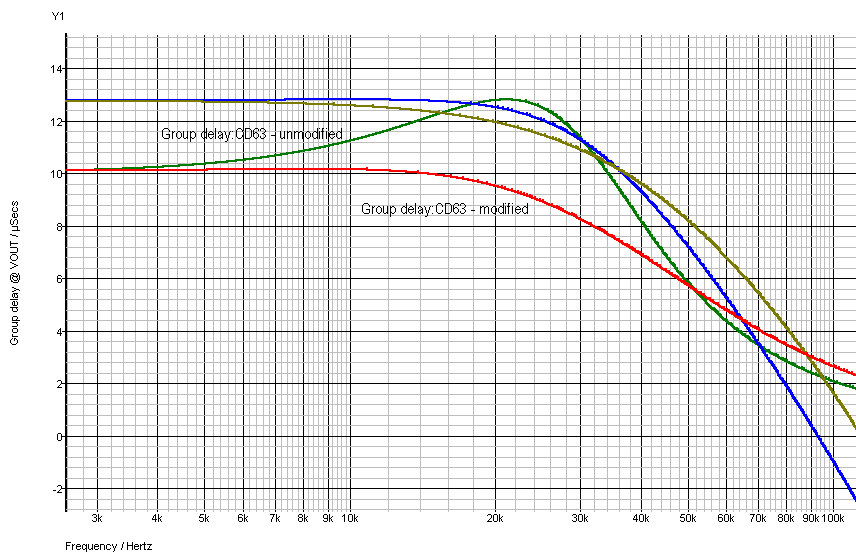Inveterate meddling #101, part 3: not quite what Ken Ishiwata intended:

In glorious closeup (well, insofar as a cheap digicamera allows):
Modifications shown here are:
Substitution of terminated coax cables for multiple data and clock traces on the circuit board and the RF signal to the HF preamp from the laser pickup.
Various bits of local shielding, many additional/substituted capacitors and several inline inductors/ferrite beads and other decoupling tricks.
Under the copper can in the centre, a new precision clock based on Elso Kwak's design for a Colpitts oscillator. Clock signal is fed to the DAC X1 input via the small coax on the right.
To the left of the clock, a dedicated ultra-low-noise power supply for it: a Sulzer-style regulator based around a buried zener reference, an opamp and fed from an external regulated supply (via the red cable).
Additional regulators fitted to supply the SAA7345 decoder analogue stage, NPC5872 DAC analogue, digital and clock stages and, just off the top of the picture, a DC-in jack for a pregulated external supply to feed the clock and DAC analogue regulators.
Modifications not visible are
The additional bypassing caps to the DAC chip from the previous page.
The backpanel switch added to kill the display completely, and a little blue LED telltale added (fitted inside the headphone socket).
The disconnection of power and signal from the headphone stage - remove U271, U272 C901 &C902 to achieve this.
The monster offboard PSU for the CD63 analogue stage. This is based around a >225VA 18-0-18V transformer (about 5Kg!) feeding 2x 4700uF capacitors via diodes with optimised snubbing. A back-panel mounted XLR socket is fitted to receive power from the offboard PSU (@ +/- 21V) and connected to C803 & 804. Diodes D801-D804 are removed and PSU caps C803 & C804 replaced with 2200uF, 50V units. The Elna Silmic 470uF, 35V parts removed here are then used next to augment C611 - C614 supplying the filter stage opamps. Analogue stage regulators Q801 and Q802 are replaced with low noise +15 and -15V units respectively. Power is also tapped off from here to feed the new clock and DAC analogue stage regulators via 100ohm/470uF RC lowpass. All a bit overkill to supply c.100mA, but If you have the parts to hand, and the nerve to build such a unit, you must try it; it leaves the internal transformer to supply just the digital stages, and gives the analogue stages the low-impedance/low-noise feed they really need. Don't bother with trying batteries here instead - they sound lousy, grey and washed-out.
Some changes to the analogue stage, converting the stock design to a 4-pole Bessel low-pass design in pursuit of constant group delay in the passband; now this is really something else.
Oh well, if you must, here's a graph from the simulations (yes, we are that sad):

Ignore the top two traces for now; the lower two tell the story. The standard (Butterworth) response has its characteristic increase in group delay prior to rolloff; the modified, Bessel, response does not - in fact it models as flat to < 0.1uS, or <1/30th the variation of the standard filter. There is no downside, unless you think that losing 1.5dB at 21Khz is significant. We don't, we just enjoy listening more than ever!
back
© the twisted pair 2002


